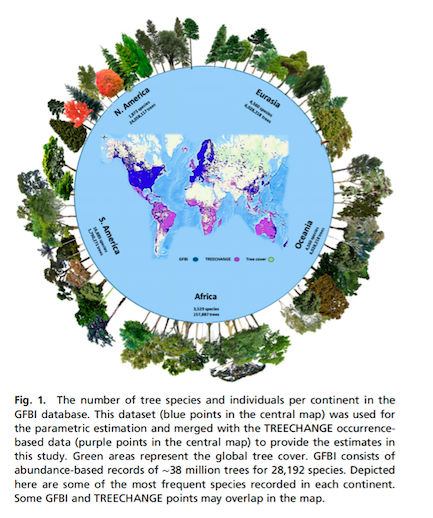
The number of tree species on Earth
RC Gatti, PB Reich, colleagues, & J Liang
https://doi.org/10.1073/pnas.2115329119
Tree species diversity is key to maintaining healthy, productive forests, and important to the global economy and to nature. And we know that around the world - from the oaks of Michigan to the Tasmanian blue gum of Australia, from California’s redwoods to the baobabs of Madagascar, there is an abundance of tree species. But until recently scientists had literally no idea how many.  By building the world’s largest forest data base -- with more than 44 million individual trees at more than 100,000 sites in 90 countries – a collaborative team of researchers co-led by IGCB’s Peter Reich was able for the first time to estimate the number of tree species on Earth.
By building the world’s largest forest data base -- with more than 44 million individual trees at more than 100,000 sites in 90 countries – a collaborative team of researchers co-led by IGCB’s Peter Reich was able for the first time to estimate the number of tree species on Earth.
The total number of tree species on Earth is around 73,000, including roughly 9,000 not yet known to science. South America, home to the enormously biodiverse Amazon rainforest and farflung Andean forests, was found to harbor 27,000 (≈40%) of the planet's known tree species and the largest number of known rare species, at about 8,200.  South America also is home 4,000 tree species yet to be identified. Biodiversity hotspots were also found in the tropics of South America, Central America, Africa, Asia and Oceania.
South America also is home 4,000 tree species yet to be identified. Biodiversity hotspots were also found in the tropics of South America, Central America, Africa, Asia and Oceania.
These findings are important for many reasons. First, because tree species are going extinct due to deforestation and climate change, understanding the value of that diversity requires us to know what is there in the first place before we lose it. By establishing a quantitative benchmark, this study thus can contribute to tree and forest conservation efforts. Second, the team discovered that one-third of known species are rare, and a much larger fraction of unknown species are likely rare as well. Rare species are far more likely to go extinct from deforestation and climate change, so learning that so many species are rare highlights the vulnerability of global forest biodiversity. Finally, at regional and local scales it is difficult to prioritize conservation efforts without a good understanding of what exists, and these data help with that, by identifying global hotspots of known and unknown rare species, which are likely to be where biodiversity is the most threatened.

